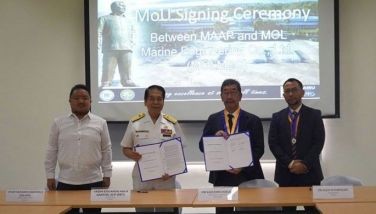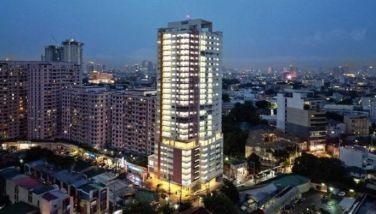Sohoton Caves: Discoveries from Leyte to Samar
MANILA, Philippines – Just like the colorful banig (mat) which the area is known for, the vibrant attractions of Leyte and Samar weave into each other with vibrant threads of rich history, progressive urbanization, and a rugged environment perfect for exciting eco-adventures, laying out a vast setting of new discoveries for any tourist.
Our first stop was the Sto. Nino Shrine and Romualdez mansion. Incidentally, guests have to take off their shoes and put on the rubber slippers provided before entering the area so as to keep the shrine and mansion clean. “The family never lived here,” the tour guide explains. “It was all just for show.”
And what a show, indeed – each room, decorated with a different theme, features pieces of furniture, paintings, artifacts and treasures from the Philippines and all over the world. Each of the guest rooms has a diorama of Imelda’s life from childhood to being crowned Rose of Tacloban, following her rise to fame – in her signature butterfly sleeves – in the country’s history.
Our next destination was a short drive to Palo, Leyte to catch a glimpse of the monument commemorating the most popular historical event to happen in the area – the MacArthur landing. The general’s celebrated return stands tall against Leyte’s clear blue sky, a testament to promises fulfilled.
Before turning in for the night, we pass by the University of the Philippines-Tacloban for the 9th Philippine Speleological Society (PSS) Cave Congress. We soon realize that these modern day “cavemen” are far evolved from their ancient equivalents with all their knowledge of the caves of the Philippines, as they explain the meaning of speleology (the scientific study of caves) and that Samar has the biggest contiguous karst (limestone) formation in the Philippines, which accounts for the numerous caves in the area, including Calbiga cave, the largest in the Philippines.
Basey, Samar, on the other hand, has over 30 caves, including the Sohoton cave, which we would explore the next day.
In their annual cave congress, more than 200 participants of the PSS tackled topics and issues related to the year’s theme, Finding the Balance Between Conservation and Tourism. “Tourism and conservation are both important,” says Jason Garrido, president of the Philippine Cave Guides Association. “We would like to streamline tourism and conservation policies,” he adds on the aim of the congress.
While it may make preservation efforts a bit harder, the leaders of PSS say that tourism is a great venue for teaching about the importance of caves to the environment. With this knowledge, they hope that visitors will find new respect not only for caves but the environment as a whole. Residents of the area definitely put more importance on the preservation and upkeep of the surroundings now that it has become a tourist attraction that they can benefit from.
“Cave tourism in the Philippines has so much room to grow,” says Jason. “We would like to implement the preservation policies while the industry is still young and controllable.”
“We are aiming for minimum- to no-impact caving,” says PSS president Bojun Bagayas, explaining that even just touching the stalactites – which take hundreds of years to form – contributes to their deterioration because of oils transferred from the human skin. Stressing the importance of preservation, he adds, “You cannot plant a cave. Once it’s gone, it’s gone forever.”
Jason considers Samar as “the ultimate caving frontier” with a karst area almost as big as Cebu. He adds that a 1-kilometer cave is the standard for a large cave, but in Samar this size is the norm. “It’s an entirely different experience,” says Jason. “There’s always a chance to discover a new area that no one has ever seen before.”
Many of today’s Filipino cavers started as mountaineers and it took opportunity and experience, hit and miss, to establish the organization they have now. Jason, who started mountaineering in high school and branched out to caving in college, says that it was caving that truly gave him profound experiences.
“When you are caving, it is pitch dark and your only world is the light around you,” he says, adding, “You really realize how small you are in the bigger scheme of things.”
The next day, we head out early to drive to Brgy. Inuntan in Basey, Samar where we would get to explore the Sohoton cave. We marvel at the bright blue sky as we cross the San Juanico bridge, the longest in the Philippines at 2.16 km. Shaped to form the “L” and “S”, the bridge connects Leyte and Samar. The curving ride on the bridge was fine, but after the bumpy ride further into Samar, many of us were wishing that we had taken the alternative route – a two-hour boat ride.
In Brgy. Inuntan, a press conference was held to launch the Sohoton Caves River Cruise, a floating restaurant that can accommodate 30 guests and offers local cuisine and entertainment as passengers enjoy the view while cruising along the river. The project is operated by the Basey Tourism Services Association (BATOSAN) which has received technical and financial assistance from the Grass Roots Entrepreneurship for Ecotourism program of the Department of Tourism (DOT).
Tourism secretary Ace Durano, who went on the river cruise and explored the cave with the group, says, “We want ecotourism to become a way of life for the people here in Basey. Right now it is additional income for them, but our vision is that this will become their main livelihood.”
He notes that in the past, logging companies had taken advantage of the area and were able to profit greatly from it, but the locals, as well as the environment, did not benefit from it. With ecotourism, the community earns a living while preserving the beauty of their surroundings. The DOT and the local government, with the BATOSAN, continue to develop the area for ecotourism.
After a grueling trek to the mouth of the cave, the coolness inside is comforting. But the darkness isn’t. Catching up to my group after almost being left behind because I stopped to take pictures, I feel a bat’s wing all but graze my cheek as it flies by.
Further into the cave, the initial fear is replaced with awe as we marvel at the different formations, some shaped like angels, animals, even the Statue of Liberty. The cave is huge – in prehistoric times, it must have been a caveman’s mansion. As we walk, water drips from the ceiling. In 100 years, it would form one square inch of stalagmite. My favorite discovery in the cave was the sparkling brown calcite on one of the cave walls. If the cave was not well preserved, the brown calcite would be dull and dead. Near the cave’s exit, our guide says, “You’ll never get lost here,” showing us the rock formation pointing towards the way out.
After an adventure-packed day, we drove back to Tacloban to unwind at Rafael’s Farm. It’s peaceful setting and delicious food was a great way to relax as we contemplated the events of the day while watching the sunset.
When asked what keeps him excited about caving even after more than 20 years of exploration, Bojun says, “I believe there is so much more to discover.” The same thing can be said about the Leyte-Samar stretch – from the Imeldific to the historical to the adventurous, there is so much to be discovered around every corner. In the land of fulfilled promises, I find myself quoting the renowned general: “I shall return.”
For more information, contact the DOT regional office at (53) 321-2048 or visit www.visiteasternvisayas.ph.
- Latest
- Trending














